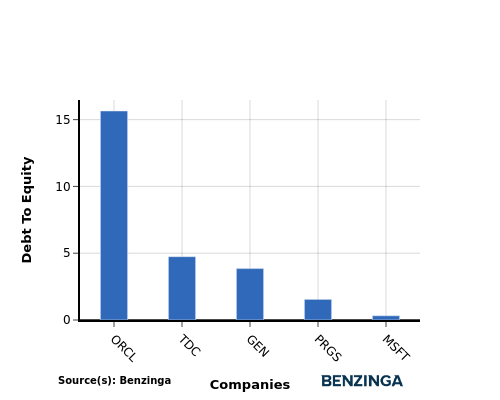Competitor Analysis: Evaluating Microsoft And Competitors In Software Industry
Author: Benzinga Insights | April 29, 2024 11:00am
Amidst today's fast-paced and highly competitive business environment, it is crucial for investors and industry enthusiasts to conduct comprehensive company evaluations. In this article, we will delve into an extensive industry comparison, evaluating Microsoft (NASDAQ:MSFT) in comparison to its major competitors within the Software industry. By analyzing critical financial metrics, market position, and growth potential, our objective is to provide valuable insights for investors and offer a deeper understanding of company's performance in the industry.
Microsoft Background
Microsoft develops and licenses consumer and enterprise software. It is known for its Windows operating systems and Office productivity suite. The company is organized into three equally sized broad segments: productivity and business processes (legacy Microsoft Office, cloud-based Office 365, Exchange, SharePoint, Skype, LinkedIn, Dynamics), intelligence cloud (infrastructure- and platform-as-a-service offerings Azure, Windows Server OS, SQL Server), and more personal computing (Windows Client, Xbox, Bing search, display advertising, and Surface laptops, tablets, and desktops).
| Company |
P/E |
P/B |
P/S |
ROE |
EBITDA (in billions) |
Gross Profit (in billions) |
Revenue Growth |
| Microsoft Corp |
35.21 |
11.93 |
12.82 |
8.93% |
$33.55 |
$43.35 |
17.03% |
| Oracle Corp |
30.93 |
57.29 |
6.28 |
50.61% |
$5.3 |
$9.41 |
7.11% |
| ServiceNow Inc |
77.30 |
18.33 |
15.77 |
4.41% |
$0.46 |
$2.08 |
6.81% |
| Palo Alto Networks Inc |
45.11 |
21.61 |
13.61 |
53.52% |
$0.21 |
$1.48 |
19.33% |
| CrowdStrike Holdings Inc |
821.81 |
31.92 |
24.25 |
2.48% |
$0.12 |
$0.64 |
32.63% |
| Gen Digital Inc |
9.33 |
5.43 |
3.50 |
5.96% |
$0.47 |
$0.77 |
1.6% |
| Dolby Laboratories Inc |
41.25 |
3.23 |
6.05 |
2.85% |
$0.09 |
$0.28 |
-5.78% |
| Qualys Inc |
42.27 |
17.10 |
11.55 |
11.75% |
$0.05 |
$0.12 |
10.49% |
| Teradata Corp |
61.75 |
27.26 |
2.10 |
-5.45% |
$0.06 |
$0.28 |
1.11% |
| N-able Inc |
95.38 |
3.22 |
5.47 |
1.35% |
$0.03 |
$0.09 |
13.22% |
| Progress Software Corp |
32.48 |
4.71 |
3.15 |
4.91% |
$0.06 |
$0.15 |
12.46% |
| Average |
125.76 |
19.01 |
9.17 |
13.24% |
$0.68 |
$1.53 |
9.9% |
By carefully studying Microsoft, we can deduce the following trends:
-
With a Price to Earnings ratio of 35.21, which is 0.28x less than the industry average, the stock shows potential for growth at a reasonable price, making it an interesting consideration for market participants.
-
With a Price to Book ratio of 11.93, significantly falling below the industry average by 0.63x, it suggests undervaluation and the possibility of untapped growth prospects.
-
The Price to Sales ratio of 12.82, which is 1.4x the industry average, suggests the stock could potentially be overvalued in relation to its sales performance compared to its peers.
-
The company has a lower Return on Equity (ROE) of 8.93%, which is 4.31% below the industry average. This indicates potential inefficiency in utilizing equity to generate profits, which could be attributed to various factors.
-
Compared to its industry, the company has higher Earnings Before Interest, Taxes, Depreciation, and Amortization (EBITDA) of $33.55 Billion, which is 49.34x above the industry average, indicating stronger profitability and robust cash flow generation.
-
Compared to its industry, the company has higher gross profit of $43.35 Billion, which indicates 28.33x above the industry average, indicating stronger profitability and higher earnings from its core operations.
-
The company's revenue growth of 17.03% is notably higher compared to the industry average of 9.9%, showcasing exceptional sales performance and strong demand for its products or services.
Debt To Equity Ratio

The debt-to-equity (D/E) ratio gauges the extent to which a company has financed its operations through debt relative to equity.
Considering the debt-to-equity ratio in industry comparisons allows for a concise evaluation of a company's financial health and risk profile, aiding in informed decision-making.
By evaluating Microsoft against its top 4 peers in terms of the Debt-to-Equity ratio, the following observations arise:
-
Compared to its top 4 peers, Microsoft has a stronger financial position indicated by its lower debt-to-equity ratio of 0.32.
-
This suggests that the company relies less on debt financing and has a more favorable balance between debt and equity, which can be seen as a positive attribute by investors.
Key Takeaways
For Microsoft in the Software industry, the PE and PB ratios are low compared to peers, indicating potential undervaluation. However, the high PS ratio suggests investors are willing to pay a premium for revenue. The low ROE may indicate lower profitability compared to peers, while the high EBITDA and gross profit suggest strong operational performance. Additionally, the high revenue growth implies a positive outlook for future earnings potential.
This article was generated by Benzinga's automated content engine and reviewed by an editor.
Posted In: MSFT





